
Wehrpass Lindhorst
Zimmermann completedAbiturl. He had school learned French and English. He was awarded the German Turn und Sport Abzeichen, the SA Sport Badge, the DLRG Grundschein.
He volunteered for military service and was found fit at his intake medical exam, 16 January 1936.
He went to the Reichsarbeitsdenst on 19 April 1936, and wea released from his obligations as a Vormann, 26 September 1936, Marburg.
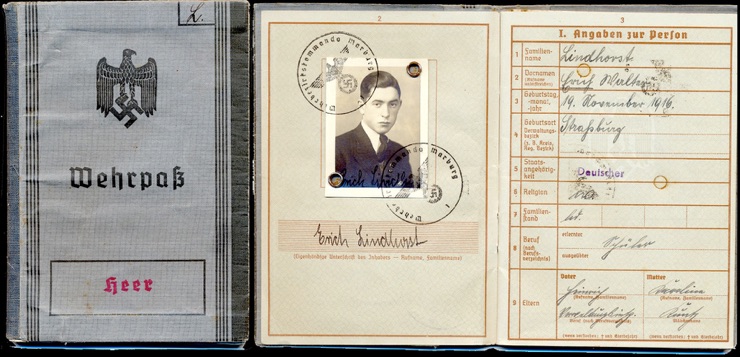
Wehrpass for Erich Lindhorst, born 19 November 1916, Strassbürg. He was a single student.
The Wehrpass was started in Trier, 6 April 1936.

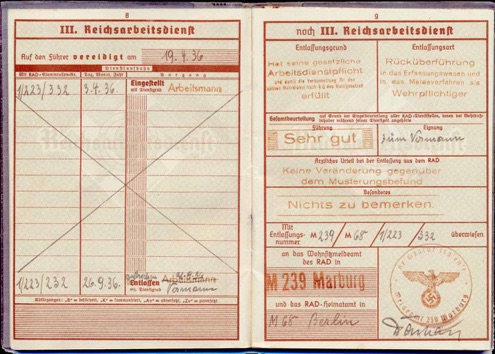
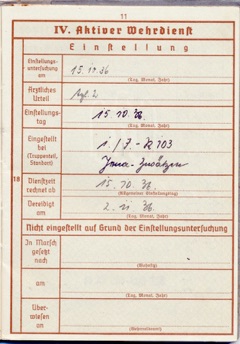
From 15 October to 2 November 1936, he was with Infantry Regiment 103.

From 15 October to 2 November 1936, he was with 1 Infantry Regiment 103. From 1 June 1937 to 2 July 1937, he was with 2 Infantry Regiment 103. 3 July to 15 October 1937, he was with 7 Infantry Regiment 103. 12 August 1938 to 10 November 1938, he was with 10 Infantry Regiment 52. From 16 October 1937 to 1 July 1938, he was at the War College at Dresden. From 2 July 1938 to 11 August 1938, he was at Infantry School at Doberitz. 10 November 1938 to 2 February 1940, he was with 3 Machine Gun Bataillon 7. From 3 February 1940 to 6 May 1940, he was with Machine Gun Ersatz Komp 7. 7 May to 19 May 1940, 3 Machine Gun Bataillon 7. 20 May 10 to 15 August 1940, Stab Machine Gun Batallion 7. From 16 August 1940 to 17 July 1941, he served with Stab Krad Schutzen Batallion 64.
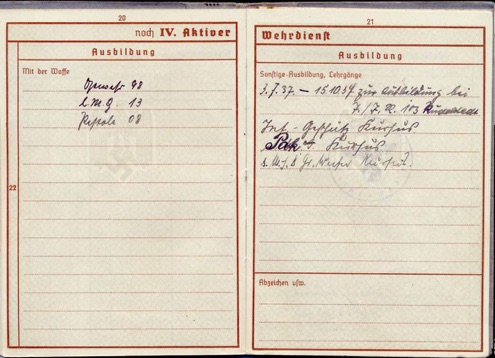
He was trained on Gewehr 98, light machine gun 13, and pistol 08.
Page 21 shows he was training from 3 July to 15 October 1937 with 7 Infantry Regiment 103. It goes on to record he completed the Infantry Geschoss Course, the Pak (anti tank) Course and heavy machine gun and Granat Werfer (motrar) Courses.
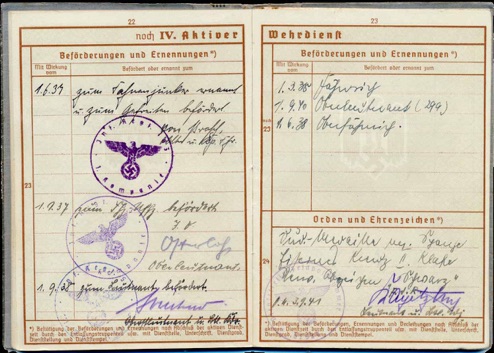
On 1 June 1937, he was a Fahnenjunker and was promoted to Gefreiter. 1 September 1937, he was promoted to Fahnenjunker Unteroffizier. On 1 September 1938, he was promoted to Leutnant.
On page 23, it lists he had been a Fähnrich 1 March 1938. Oberfähnrich on 1 June 1938. It also records that he was promoted to Oberleutnant 1 September 1940.
He was awarded the Czech Anschluss Medal with Prag Bar. He was also awarded the Iron Cross 2nd Class and the Black Wound Badge and the entries were dated 3 September 1941.
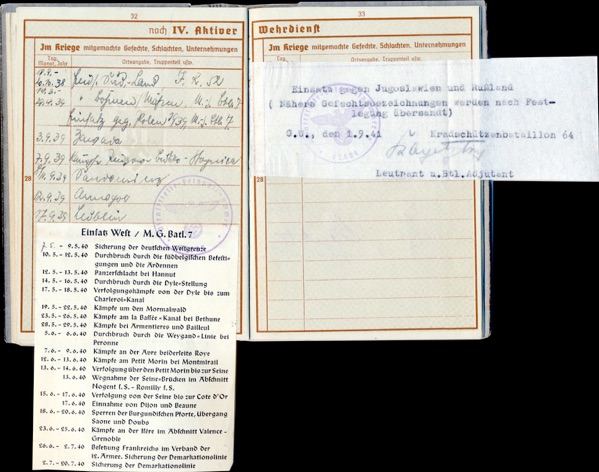
The Wehrpass has 2 glue-ins for his combat. From 18 September 1938 to 20 October 1938, he was in the Sudetenland, Böhem-Mähren with Machine Gun Batallion 7 Infantry Regiment 52. 2 September 1939, still with Machine Gun Batallion 7, they were already in Petersgrätz. The 7th had been held in reserve and was given their marching orders to “cross the line”, 3 September, at Zadawa. 7 September “combat” in Stopnica is entered. 8 to 11 September, they were in Sandomierz. 12 September, they advanced to Annopol. 17 September they were in Lublin, and confronted by Polish machine guns. As they had no artillery support, they were forced to withdraw at dusk. The 4th Infantry Division arrived and its commander admonsihed the 7th Commander, Oberstleutnant Freiherr von Falkenstein. (As is shown later in this Wehrpass, Lindhorst had been wounded by a bullet to the thigh at Lublin.
The glue-in lists the campaign in the West.
7 - 9 May 1940, Securing the Western Border. 10-12 May, break through the Ardennes. 12-13 May, Panzer battle at Hannut. 14-16 May, break through the Dyle Stellung. 17-18 May, fighting from the Dyle to the Charleroi Kanal. 19-22 May, fighting in Mormalwald. 23-26 May, fighting at Bassee Kanal and Bethune. 28-29 May, fighting by Armentieres and Bailleul. 5-6 June, break through the Weygand Line by Peronne. 7-9 June, fighting on the Avre. 12-13 June, fighting by Petit Morin by Montmirail. 13-14 June, cross the Petit Morin to the Seine. 13 June, cross the Seine Bridge in the area of Nogent. 15-17 June, cross from the Seine to the Cote d’ Or. 17 June, Dijon and Beaune. 18-20 June, block off the Burgundy Fort and the crossing to Saone and Doube. 23-25 June, fighting on the Ifere in the area of Valence-Grenoble. 26 June to 2 July, Occupation of France by the 18 Amree and securing the Demarkationsline. 2 -20 July 1940, Securing the Demarkationsline.
On 16 August 1940, the Bataillon was reassigned to the 64 Kradschützen Bataillon of the 14 Panzer Division. They spent a period of reorganization before being sent to Poland, January 1941. In March 1941, they took part in the Invasion of Yugoslavia and seized two bridgeheads by Barcs and Zakany. 19 April they were at Sarajevo. 24 April 1941, they began their northward withdrawl towards the military camp at Döberitz by Berlin, to prepare for Operation Barbarossa. On 6 June 1941, the division was in Radom, Poland, and it was here they began the Russian Offensive. 22 June 1941, they were by Uscilug and on 24-25 June, they engaged in a battle on Panzers by Alexandrowka. 1 Juy, they had advanced to the area of Rowno. They engaged in difficult fighting by Zwaihel and broke through 9 July to the Stalin Line. On 23 July , they reached Belaja Zerkow, but on 17 September Lindhorst was killed by an artillery round just north of Shitomir. (The glue-n notes Yuroslavia and Russia and the ink stamp’s Feldpost # is for Kradschützen Bataillon 63)